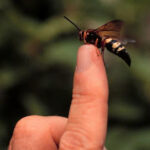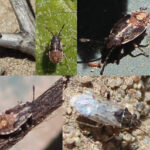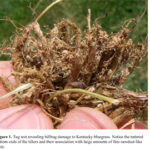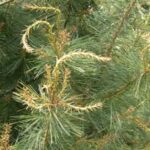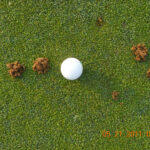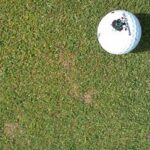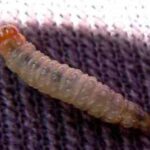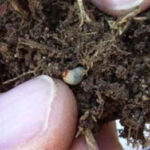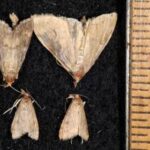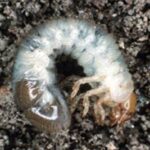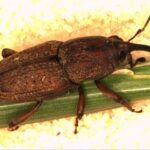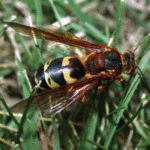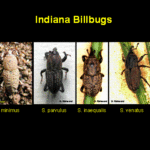Category: Insect Control
Cicada killers are Wimps
Spread the word – Cicada killers are wimps! Unfortunately, because of their size and the fact that they often live in lawns and landscapes close to where people live, cicada killers evoke a great deal of anxiety. These wasps are huge and look very much like oversized yellow jackets but they have some very important […]
Ground Moving with Tiny Migrating Insects
Whenever I give my ‘General Insect Pest’ presentations I include a couple of photos of chinch bugs and their nymphs. Usually I say something like “These are not pests every year in Indiana but can become troublesome in years when we have a drought.” Guess what? That is now! The dry conditions we are […]
Japanese Beetle Emergence and Management
Below is an e-mail conversation that may be of benefit to other turfgrass managers asking similar questions. Original message: From: Golf Courses Date: Friday, June 22, 9:30 AM To: Gibb, Timothy “Gibb, Timothy” <gibb@purdue.edu> Subject: Japanese Beetles Management in 2012 With the early spring we expected to see early Japanese Beetles. We did […]
Early Billbug Damage Reported Across the Midwest
This season continues to challenge our traditional thinking about insect seasonal ecology and management. Indiana and neighboring states are currently witnessing serious billbug infestations with late instar billbug larvae already present in the soil. This activity is easily 2-3 weeks ahead of normal. We advise all turf managers to take a close look at areas […]
Early Spring Insect Update
Not surprisingly, the early spring warm-up has resulted in a frenzy of early season insect activity. We were out in the field earlier this week to get a handle on just how far ahead insect activity may be this year and we were somewhat exasperated by what we found… Billbugs Billbugs are out in […]
Purdue Turf Scientists and Their Work Highlighted in Recent Press Releases
Scientists make turfgrass safer for animals, deadly for insects September 6, 2011 WEST LAFAYETTE, Ind. – The right combination of compounds produced by a beneficial fungus could lead to grasses that require fewer pesticides and are safer for wildlife and grazing animals, according to Purdue University scientists. Read More Purdue ‘tool box’ could be […]
Herbicide damage on Spruce and Pine
The Plant and Pest Diagnostic Lab (PPDL) has recently received several samples of Norway spruce and white pine with symptoms that appear to be associated with injury caused by synthetic auxin (growth regulator type) herbicides. Typical off-target symptoms caused by these herbicides can include epinasty (twisting and curling) of the shoot and tips (Fig. 1) […]
Mound Making on Greens and Tees
In addition to earthworms, there are several insects that can create small mounds of soil above the surface of turfgrass. Usually such mounding is of minimal consequence and, in fact, is beneficial to turfgrass environments as it accomplishes the same thing as cultivation, aeration and top-dressing – only on a very small scale. On occasion, […]
Sod webworms
Sod webworms may cause damage to closely mowed turfgrass early in the spring. Damage, similar to that depicted in the photos below, may be seen on golf tees and greens. The overwintered caterpillars become active when the temperatures warm up in the spring and begin to tunnel and feed. They are mostly active at night, […]
Spring Grub Control Not Your Best Bet
Spring is almost upon us and overwintering white grubs will soon be emerging from the depths to continue feeding for a short time before they pupate. These overwintering grubs typically spend the frigid months of December – February deep in the soil profile (up to 12 inches deep) to avoid freezing. As soil temperatures begin […]
Late Season Insects Found in Turfgrass
The following letter and pictures were sent to us for identification. There was a buzz of follow-up letters and communication afterward indicating that maybe this is not just an isolated occurrence. I have enclosed the initial letter, accompanying photographs and the return response in hopes that this is of value to others noticing the same […]
Summer Stress
With a warm and wet summer, we are experiencing decline in some of our turf around the state due to temperatures, disease, insects, and weeds. In response, we are publishing a four part series on this topic to help turfgrass managers respond. Look forward to the following topics over the next two weeks. Part I: […]
Grass Moths Everywhere
If you have walked out on your lawn recently you may have noticed hundreds of small, buff colored, moths flittering here or there as you approach. These may be alarming for both farmers as well as turfgrass managers because they; look like a common corn pest (European Corn Borer) act like a common turfgrass pest […]
August Is Grub Target Month
This is the time of year to target for grub control. Whether your grub control products were applied a month ago, last week or are to be applied next week, the time when they actually do their work is early August. This is because grub eggs usually hatch by the end of July in the […]
Hunting Billbugs in Zoysiagrass
Hunting billbug is becoming a significant problem in parts of southern Indiana where zoysiagrass is grown. These insects typically have two generations per year in this part of the Midwest with the larvae of both generations being capable of causing significant injury to turf. Sporadic adult hunting billbug activity has already been observed in the […]
Cicada killers: A Nuisance or a Danger?
A number of solitary bees and wasps reside in turfgrass and landscapes. Because of their ability to harm humans, these insects often evoke a great deal of anxiety. However, in reality they very rarely sting. Education is the single best strategy to help people deal with cicada killers. Cicada killers are one of the largest […]
White Grub Biology and Control in Espanol
In response to requests from our industry, we will be teaching a workshop in Spanish at Field Day on July 21. “White Grub Biology and Control” will be taught by Victoria Caceres from the Department of Entomology. This is a great opportunity for you or any of your staff who are comfortable learning in Spanish […]
Season-long Grub Control Advertisements
Grub control products are currently being displayed in the center aisles of retail department and discount stores and are advertised on the radio as providing season-long grub control when applied in early May. What are the facts behind this recommendation? While certain grub control products do have a very long residual in the soil, they […]
Billbugs on the move in Southern Indiana
Superintendants and lawn care professionals in the southernmost counties of Indiana should be advised that adult billbug activity has already been documented at one of the monitoring sites in the Evansville area. Mr. Jeff Sexton, Assistant Superintendant at Rolling Hills Country Club in Newburgh, Indiana captured his first billbugs adults of the year last week. […]
Billbugs a Pest in 2008? Keep Them in Mind for 2009
This summer saw some extensive billbug damage in many parts of Indiana. Obvious damage to Kentucky bluegrass in the central and northern parts of the state are not uncommon and can usually be attributed to the bluegrass billbug. However, reports of severe damage to Zoysiagrass in the Evansville area really caught my attention. Zoysiagrass is […]
